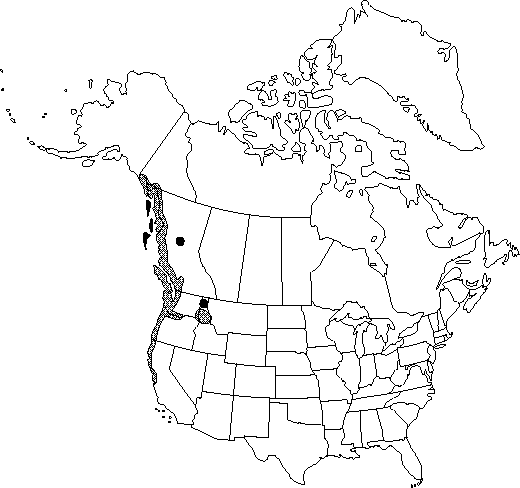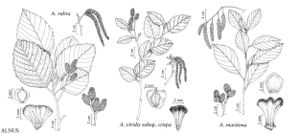Alnus rubra
Mém. Acad. Sci. St.-Pétersbourg, Sér. 6, Sci. Math. 2: 162. 1833.
Trees, to 28 m; trunks often several, crowns narrow or pyramidal. Bark gray, smooth, darkening and breaking into shallow rectangular plates in age; lenticels inconspicuous. Winter buds stipitate, ellipsoid, 6–10 mm, apex rounded, long; stalks 2–8 mm; scales 2–3, outer 2 equal and valvate, usually heavily resin-coated. Leaf-blade ovate to elliptic, 6–16 × 3–11 cm, leathery, base broadly cuneate to rounded, margins strongly revolute, deeply doubly serrate or crenate, with distinctly larger secondary teeth, apex acute to obtuse; surfaces abaxially glabrous to sparsely pubescent. Inflorescences formed season before flowering and exposed during winter; staminate catkins in 1 or more clusters of 2–6, 3.5–14 cm; sistillate catkins in 1 or more clusters of 3–8. Flowering before new growth in spring. Infructescences ovoid to nearly globose, 1–3.5 × 0.6–1.5 cm; peduncles 1–10 mm. Samaras ovate or elliptic, wings much narrower than body, irregularly elliptic to obovate, leathery. 2n = 28.
Phenology: Flowering early spring.
Habitat: Stream banks, moist flood plains, lake shores, wet slopes, and sandy, open coasts
Elevation: 0–300 m
Distribution

B.C., Yukon, Alaska, Calif., Idaho, Oreg., Wash.
Discussion
Alnus rubra is the largest alder in North America north of Mexico; it often forms extensive stands along streams and on low-lying flood plains in the Pacific Northwest. The strongly revolute margins of its leaf blades make it easily distinguished from all of the other alders in the flora. It is an important commercial tree; the wood is used to make inexpensive furniture, small wooden items, and paper pulp.
Native Americans used various parts of plants of Alnus rubra medicinally as a purgative, an emetic, for aching bones, headaches, coughs, biliousness, stomach problems, scrofula sores, tuberculosis, asthma, and eczema, and as a general panacea (D. E. Moerman 1986).
Selected References
None.
